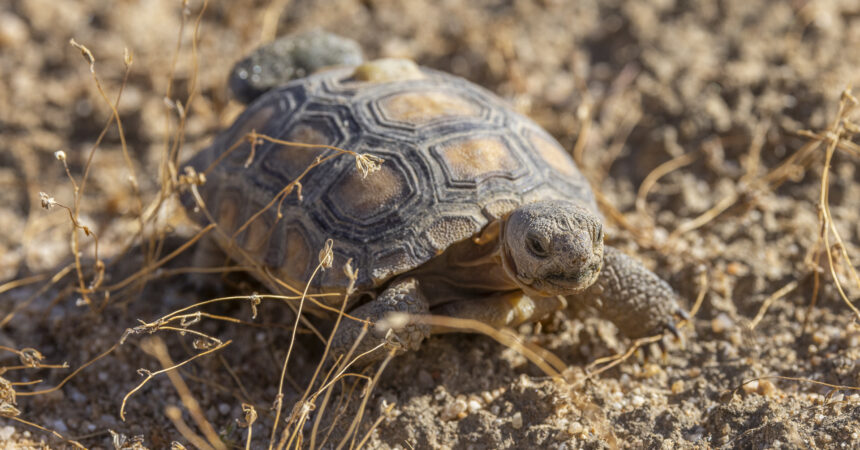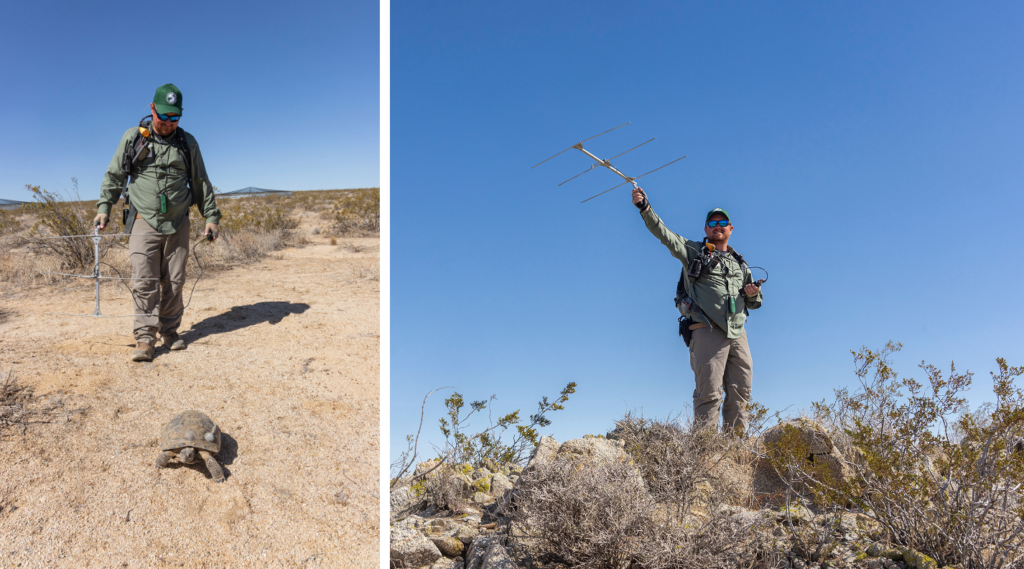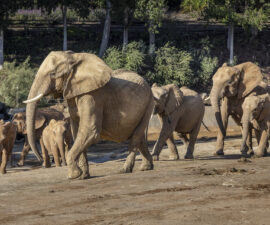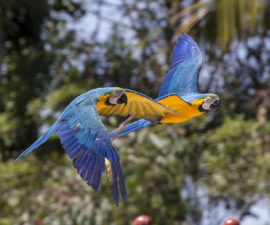Helping Mojave Desert Tortoises Survive in a Rapidly Changing World
The sun climbs above a ridgeline in the western Mojave Desert, where a female Mojave desert tortoise emerges from her burrow. Blinking in the bright daylight, she basks in the warmth. She has seen thousands of sunrises in her more than 50 years of life, and she’s also been a witness to many changes during that time.
While it was once sparsely populated, the number of people inhabiting the Mojave Desert she calls home has doubled since she hatched. As more people arrived, so too did increasing demands on the landscape from mining, renewable energy installations, water use, recreation, transportation, and development.
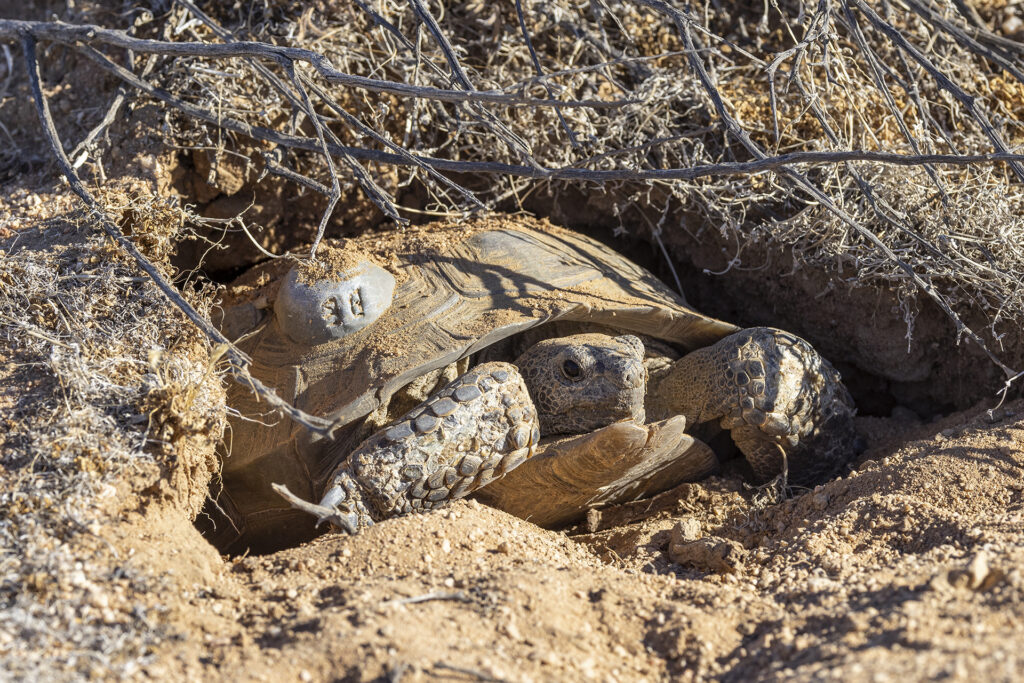
When this tortoise hatched, she could travel long distances without crossing major roads or off-highway vehicle routes, human settlements or developed areas, which are cleared of native vegetation. She would regularly encounter other desert tortoises, or signs of them, while moving between burrows and foraging areas.
The density of tortoises in this native habitat was once quite high—over 100 per square mile in many places. This means she was familiar with her neighbors and when she reached adulthood, she was more likely to encounter a mate and successfully reproduce. As a hatchling, this female was the size of a ping pong ball and vulnerable to many predators. Fortunately for her, predators such as ravens and coyotes occurred at low densities 50 years ago, while abundant native shrubs, burrows, and other landscape features allowed her to stay well-hidden, to survive and grow.
Today desert tortoise populations are threatened and facing extinction. With the support of allies like you, we’re working collaboratively with partners to protect and save this local species through our Southwest Conservation Hub.
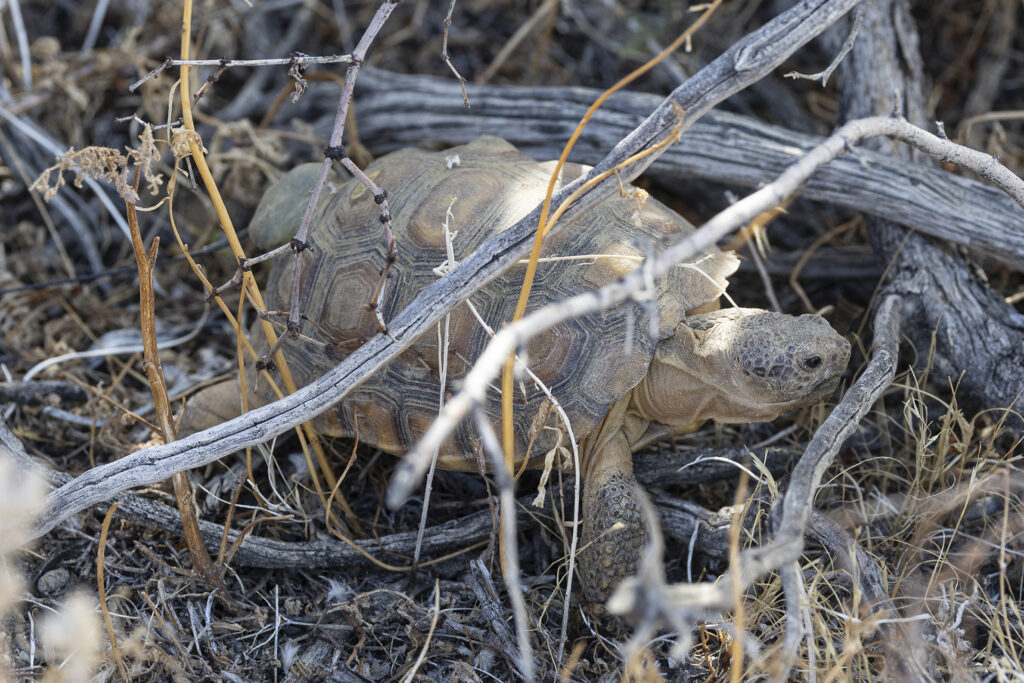
These tortoises face a variety of threats. There are 5 to 10 times more ravens within its range compared to 50 years ago, largely because these birds are successful at taking advantage of the refuse that arrives in an area when people do. Byproducts of human development like trash, landfills, and wastewater are surprisingly beneficial to species like ravens and coyotes, allowing them to become what is known as “subsidized predators” in the Mojave Desert. As a result, populations grow far beyond what could be supported by the harsh desert environment alone. People provide other important resources, too, including tall non-native trees, power transmission lines and towers, billboards, and abandoned buildings that serve as safe places to nest and raise more generations of ravens.
Young tortoises have few defenses against intelligent predators like ravens, and running away is not an option. A youngster’s shell is soft and easily punctured by strong beaks, and tiny tortoise hatchlings are easily carried off. These birds are very good at learning how to search for vulnerable young tortoises and can consume as many as 6 out of every 10 hatchlings. In fact, studies have shown that young tortoises living more than a mile away from raven nests survive longer than those living less than a mile away. So, with increasing raven populations, fewer tortoises are surviving to adulthood.
This increased predation, along with threats from vehicles, disease, habitat degradation, and wildfires, has led to a dramatic decrease in desert tortoise populations, with fewer than 10 per square mile surviving in some areas—a 90 percent decline. Lower tortoise densities make it hard for this species to find mates, and for the few who do mate successfully, their offspring face low chances of survival.
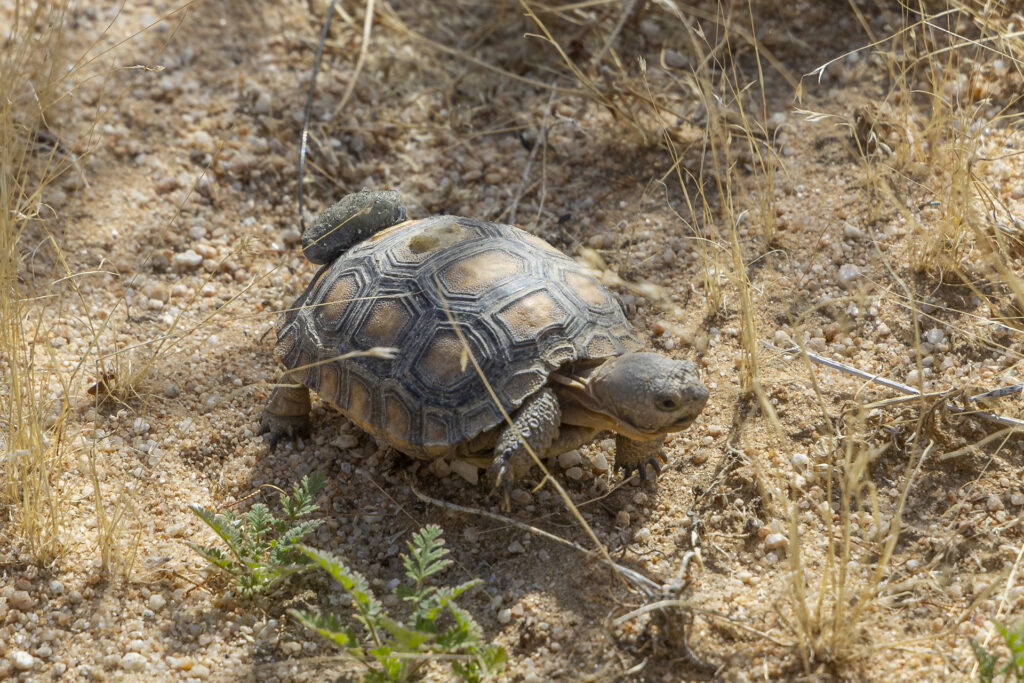
Scientists have learned a lot about what adult desert tortoises need to thrive, but we know less about what makes an ideal habitat for juveniles because there are so few young left to study. There may be certain habitat features that help them stay safe when they’re small. What we do know is that once tortoises grow to about four inches long, they are much less vulnerable to raven predation—but it can take them seven years to achieve this size. This long period of vulnerability, coupled with uncertainty about their habitat requirements, poses a real challenge to recovering the species.
Desert Tortoises Get a Head Start
Headstarting is a conservation tool that helps threatened species survive vulnerable periods. During this process, young and vulnerable wildlife are protected and cared for until they grow large and strong enough to survive in their native habitats. We’ve been working to understand best practices for headstarting and reintroducing Mojave desert tortoises for over a decade.
Working closely with partners at the U.S. Fish and Wildlife Service, U.S. Geological Survey, California Department of Fish and Wildlife, Edwards Air Force Base, and others, the San Diego Zoo Wildlife Alliance Desert Tortoise Recovery Program is focused on reducing threats by raising juvenile tortoises in protected conditions during their most vulnerable life stage (eggs and hatchlings). After they’re reintroduced into native habitats, we study which habitat features are most important for ensuring the juveniles’ survival.
Our headstart process begins with adult female tortoises in their native habitat who are tracked throughout the year with radio telemetry. In the spring, these tortoise moms-to-be are monitored with a mobile x-ray unit to determine if they are carrying eggs. Females with eggs are brought into a protected outdoor headstart facility at Edwards Air Force Base, where they are offered private areas with burrows for egg laying.
Once females have laid their eggs, they’re returned to their native habitat. The eggs are allowed to incubate and hatch under the safety of our collaborative care, where juveniles remain for up to two years before being reintroduced. We’ve also partnered with The Living Desert Zoo and Gardens in Palm Desert, California, to develop a combination indoor-outdoor headstart program, where the hatchlings spend the first six months of life indoors in constantly maintained temperatures—a time when tortoises in native habitats are deep in burrows, not eating and not growing.
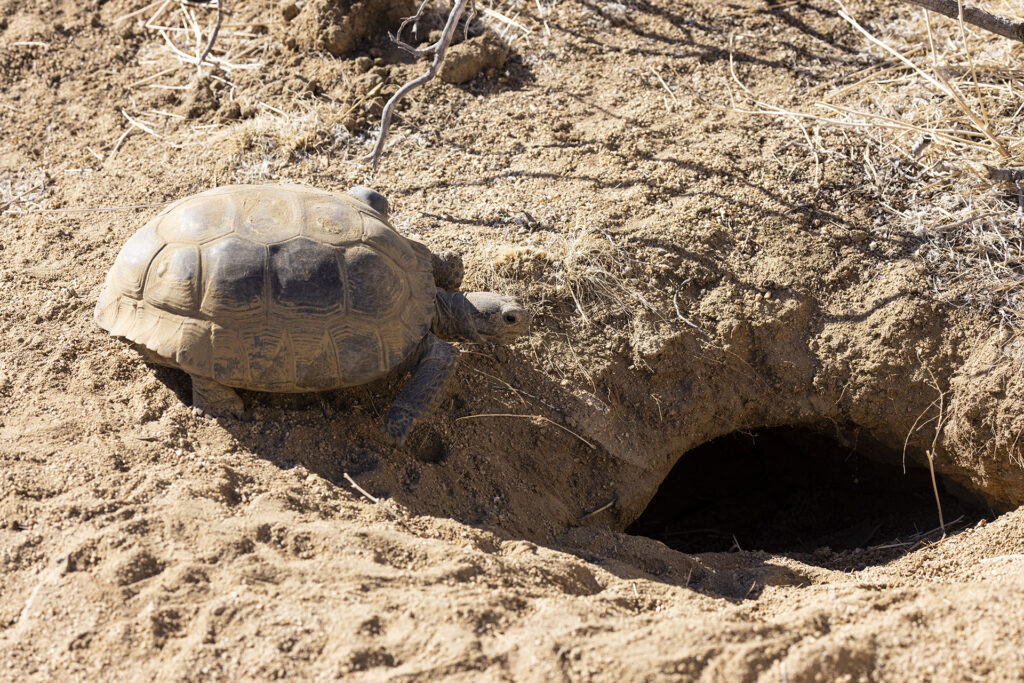
With this controlled environment that provides steady temperature, regular UV exposure, and an ample supply of nutritious food, young tortoises can grow at an astonishingly accelerated rate. After six months of being raised indoors at The Living Desert, the young tortoises return to the protected outdoor area at Edwards Air Force Base, where they spend the spring and summer acclimating to desert conditions—and continuing to grow under natural light and regular feeding. The result? After just one year of combination indoor-outdoor rearing, hatchlings can grow to the size of a five-year-old tortoise living in native habitat! This important partnership has produced young tortoises that are less vulnerable to predation in a much shorter period—an incredible success that is a beacon of hope for this endangered species.

Through these efforts, we’ve reintroduced over 200 juvenile tortoises into native Southwest habitats across California, with the next year’s cohort currently thriving at The Living Desert. Telemetry data transmitted by headstarted juvenile tortoises after reintroduction shows that sites with abundant shrub cover, native plants to eat, tortoise-sized rocks that act as camouflage, plentiful small mammal burrows, and a substrate that is easy to dig in provide young tortoises the best chance to survive and reproduce. This knowledge helps agency partners and land managers identify the best places to reintroduce young tortoises and key habitat to conserve—now and in the future. This information is also useful for selecting mitigation sites that offset habitat lost to development and establishing targets for restoration of habitat that has become degraded.
A Future with More Tortoises
An icon of the Southwest, the desert tortoise is also a keystone species of the Mojave desert community. Among their most important roles is that of ecosystem engineer. Desert tortoises are excellent diggers, and adults can excavate large, deep burrows over six feet long. Tortoise burrows provide nest sites and refuge from temperature extremes for over 45 vertebrate species, including birds, mammals, and other reptiles.
Digging activity also helps aerate and mix the soil, which benefits native desert plants and helps the water from infrequent rains reach the roots of trees and shrubs, like Joshua trees and creosote. As herbivores, desert tortoises also disperse seeds of their food plants in their poop, helping to keep the annual desert “superbloom” spectacular.
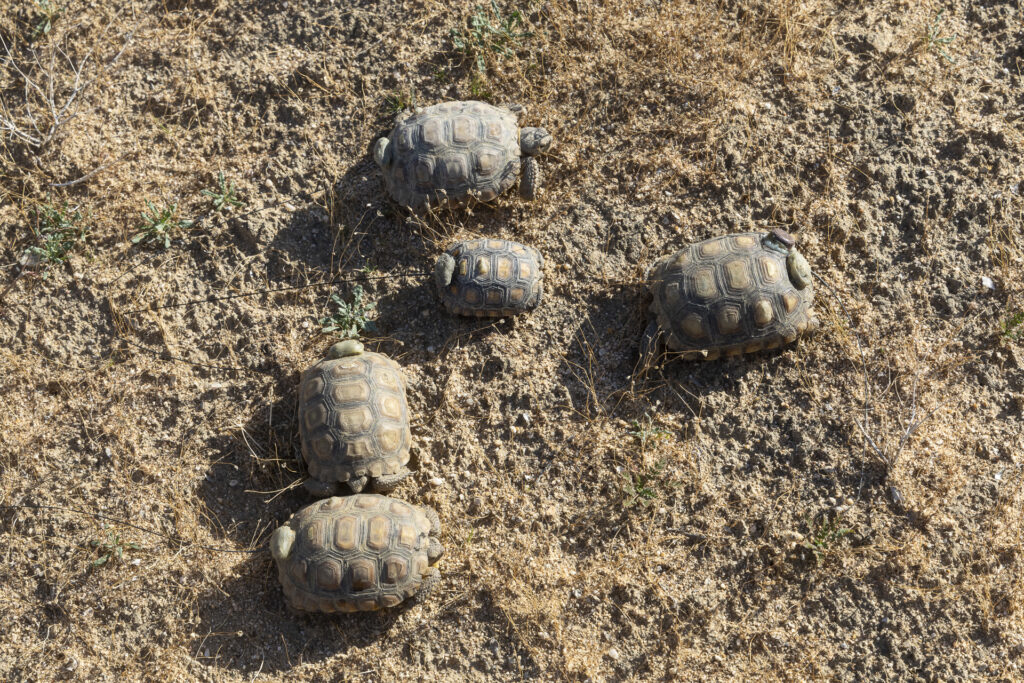
Saving and protecting the threatened desert tortoise will not only prevent the loss of a species that has persisted for millions of years, but will also help the entire ecosystem be more resilient in the face of a changing climate. Together with our dedicated partners, we’re committed to understanding what desert tortoises need to thrive for generations to come—because when wildlife thrives, all life thrives.
How to Be an Ally for Wildlife and Help Desert Tortoises
You can make a difference! If you live, travel through, or spend recreational time in desert tortoise habitat, remember to:
1. Watch your speed. Be aware that tortoises may be in or along roadways, particularly following rain, to drink from pooled water or access green vegetation in roadside ditches. Excessive speed is not only dangerous to tortoises, but it also contributes to other roadkill.
2. Check under parked cars before driving! Tortoises often seek out the shade provided by a parked vehicle.
3. Enjoy desert recreation responsibly. Only use designated routes and avoid damaging habitat by going off-road or cutting new paths. Unauthorized trail creation fragments desert tortoise habitat, disturbs fragile and living soil crusts, and facilitates the spread of non-native plants. Tortoises can also be struck by off-highway vehicles and vehicles and foot traffic can collapse their burrows.
4. Cover your trash. Keep trash can lids closed and make sure trash is picked up and placed in proper receptacles that ravens cannot access.
5. Spread the word!
Discover more about how you’re protecting desert tortoises and other vulnerable local wildlife through our Southwest Conservation Hub.

